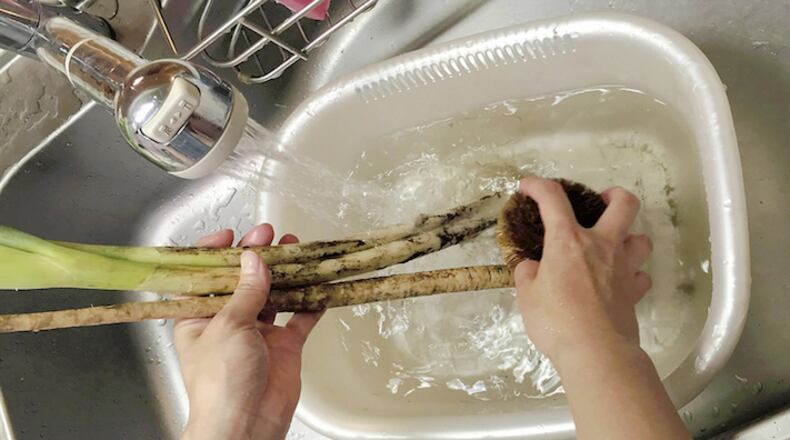It is important to handle fruits and vegetables (and all foods) properly to prevent food poisoning. Food poisoning, also called foodborne illness, is caused by eating food that contains bacteria or other germs that are harmful to health. Many food poisoning outbreaks have been associated with contaminated produce.
By taking some simple steps, we can ensure that fruits and vegetables are safe to eat:
- Wash all fruits and vegetables under running water. Do not use soap or bleach. Dry produce after washing. Fruit and vegetable wash sprays are not necessary.
- Scrub fruits and vegetables with tough skins with a produce brush under running water to remove any dirt. Even fruits and vegetables that will be peeled (potatoes, squash, melons) need to be scrubbed to prevent contamination when they are cut. If there are bacteria on the surface of the fruit or vegetable, the knife could transfer those bacteria to the inside when we cut it.
- If potatoes have green spots, peel or cut away the spots before using the potato. These green spots are not safe to eat. They are caused by exposure to light. Prevent green spots by storing potatoes in a cool, dark place.
- The Food and Drug Administration (FDA) recommends avoiding unpasteurized juice and raw sprouts.
- Separate ready-to-eat produce from raw meats while shopping for and preparing fruit and vegetables.
How to wash specific types of produce:
Leafy green vegetables. Separate and individually rinse the leaves of lettuce and other greens. Throw away the outer leaves if torn and bruised. Leaves can be difficult to clean and immersing the leaves in a bowl of chilly water for a few minutes helps loosen sand and dirt. Once dirt is removed, rinse the leaves with clean water. After washing, blot dry with paper towels or use a salad spinner to remove excess moisture.
Apples, cucumbers, and other firm produce. Wash well or peel to remove the waxy preservative.
Root vegetables. Peel potatoes, carrots, turnips, and other root vegetables, or clean them well with a firm scrub brush under lukewarm water.
Melons. The rough, netted surfaces of some types of melon provide an excellent environment for microorganisms to grow. When cutting into a melon, anything on the outside will be transferred to the edible part on the inside with the knife. To minimize the risk of foodborne illness, use a produce brush to scrub melons thoroughly under running water before peeling or slicing.
Peaches, plums, and other soft fruits. Wash under running water, and dry with a paper towel.
Grapes, cherries, and berries. Store unwashed until ready to use. Throw away any spoiled or moldy fruit before storing to prevent the rest of the fruit from spoiling. Wash gently under cool running water right before use.
Mushrooms. Clean with a soft brush, or wipe with a wet paper towel to remove dirt.
Herbs. Rinse by dipping and swishing in a bowl of cool water, and dry with paper towels.
Raw sprouts (e.g., mung bean, alfalfa, clover, radish) have been identified as a potential source of foodborne illness in the United States. The FDA offers the following advice concerning sprouts:
- Cook sprouts. This helps reduce the risk of illness. Canned sprouts are considered safe.
- Check sandwiches and salads bought at restaurants and delicatessens. They often contain raw sprouts. Consumers should ask that raw sprouts not be added to their food.
- Sprouts grown at home are also a risk if eaten raw. Many outbreaks have been attributed to contaminated seeds. If bacteria are present in or on seeds, they can grow to elevated levels during sprouting even under clean conditions.
Recipe: Brown rice with cheese and tomatoes
Makes 8 servings
Serving size: 1 cup
150 calories per serving
Ingredients:
1 tablespoon vegetable oil
1 medium onion, chopped
3 stalks celery, chopped
½ green bell pepper, chopped
2 cups cooked or canned, diced tomatoes
3 cups cooked brown rice
1 cup reduced-fat shredded cheese
Directions:
- Heat oil in frying pan.
- Add onion, celery, and pepper; cook until tender.
- Add tomatoes, rice, and cheese.
- Cover and cook slowly until cheese melts and mixture is hot.
Recipe: Cheesy breakfast burrito
Makes 2 servings
Serving size: ½ burrito
190 calories
Ingredients:
2 strips turkey bacon
2 eggs
¼ cup chopped green bell pepper
1 (10 inch) whole-wheat tortilla
1/8 cup shredded cheddar cheese
1 tomato, sliced
Directions:
- Spray skillet with non-stick cooking spray.
- Cook turkey bacon over medium-high heat, turning once, until crispy. Break into small pieces and set aside.
- Crack eggs in a bowl and lightly beat with a fork.
- Using same skillet and extra spray if needed, sauté green peppers over medium heat until tender.
- Add eggs to skillet with peppers and stir continually until eggs are set.
- Divide cooked eggs into two portions. Place one portion on top of each tortilla.
- Top with cheese, turkey bacon, and tomato.
- Wrap burrito and enjoy!
Interested in free nutrition education lessons from OSU Extension Expanded Food and Nutrition Education Program (EFNEP)? Contact Nancy Lyons at 937-224-9654 or lyons.489@osu.edu.
